Guest Post by Bob Tisdale
This post provides updates of the values for the three primary suppliers of global land+ocean surface temperature reconstructions—GISS through July 2016 and HADCRUT4 and NCEI (formerly NCDC) through June 2016—and of the two suppliers of satellite-based lower troposphere temperature composites (RSS and UAH) through July 2016. It also includes a few model-data comparisons.
This is simply an update, but it includes a good amount of background information for those new to the datasets. Because it is an update, there are no overview and summary for this post. There are, however, summaries for the individual updates. So for those familiar with the datasets, simply fast-forward to the graphs and read the summaries under the heading of “Update”.
(I’m still on holiday, so I may not get a chance to respond to comments.)
INITIAL NOTES:
We discussed and illustrated the impacts of the adjustments to surface temperature data in the posts:
- Do the Adjustments to Sea Surface Temperature Data Lower the Global Warming Rate?
- UPDATED: Do the Adjustments to Land Surface Temperature Data Increase the Reported Global Warming Rate?
- Do the Adjustments to the Global Land+Ocean Surface Temperature Data Always Decrease the Reported Global Warming Rate?
The NOAA NCEI product is the new global land+ocean surface reconstruction with the manufactured warming presented in Karl et al. (2015). For summaries of the oddities found in the new NOAA ERSST.v4 “pause-buster” sea surface temperature data see the posts:
- The Oddities in NOAA’s New “Pause-Buster” Sea Surface Temperature Product – An Overview of Past Posts
- On the Monumental Differences in Warming Rates between Global Sea Surface Temperature Datasets during the NOAA-Picked Global-Warming Hiatus Period of 2000 to 2014
Even though the changes to the ERSST reconstruction since 1998 cannot be justified by the night marine air temperature product that was used as a reference for bias adjustments (See comparison graph here), and even though NOAA appears to have manipulated the parameters (tuning knobs) in their sea surface temperature model to produce high warming rates (See the post here), GISS also switched to the new “pause-buster” NCEI ERSST.v4 sea surface temperature reconstruction with their July 2015 update.
The UKMO also recently made adjustments to their HadCRUT4 product, but they are minor compared to the GISS and NCEI adjustments.
We’re using the UAH lower troposphere temperature anomalies Release 6.5 for this post even though it’s in beta form. And for those who wish to whine about my portrayals of the changes to the UAH and to the GISS and NCEI products, see the post here.
The GISS LOTI and NCEI surface temperature reconstructions and the two lower troposphere temperature composites are for the most recent month. The HADCRUT4 product lags one month.
Much of the following text is boilerplate that has been updated for all products. The boilerplate is intended for those new to the presentation of global surface temperature anomalies.
Most of the graphs in the update start in 1979. That’s a commonly used start year for global temperature products because many of the satellite-based temperature composites start then.
We discussed why the three suppliers of surface temperature products use different base years for anomalies in chapter 1.25 – Many, But Not All, Climate Metrics Are Presented in Anomaly and in Absolute Forms of my free ebook On Global Warming and the Illusion of Control – Part 1 (25MB).
Since the July 2015 update, we’re using the UKMO’s HadCRUT4 reconstruction for the model-data comparisons using 61-month filters.
And I’ve resurrected the model-data 30-year trend comparison using the GISS Land-Ocean Temperature Index (LOTI) data.
For a change of pace, let’s start with the lower troposphere temperature data. I’ve left the illustration numbering as it was in the past when we began with the surface-based data.
UAH LOWER TROPOSPHERE TEMPERATURE ANOMALY COMPOSITE (UAH TLT)
Special sensors (microwave sounding units) aboard satellites have orbited the Earth since the late 1970s, allowing scientists to calculate the temperatures of the atmosphere at various heights above sea level (lower troposphere, mid troposphere, tropopause and lower stratosphere). The atmospheric temperature values are calculated from a series of satellites with overlapping operation periods, not from a single satellite. Because the atmospheric temperature products rely on numerous satellites, they are known as composites. The level nearest to the surface of the Earth is the lower troposphere. The lower troposphere temperature composite include the altitudes of zero to about 12,500 meters, but are most heavily weighted to the altitudes of less than 3000 meters. See the left-hand cell of the illustration here.
The monthly UAH lower troposphere temperature composite is the product of the Earth System Science Center of the University of Alabama in Huntsville (UAH). UAH provides the lower troposphere temperature anomalies broken down into numerous subsets. See the webpage here. The UAH lower troposphere temperature composite are supported by Christy et al. (2000) MSU Tropospheric Temperatures: Dataset Construction and Radiosonde Comparisons. Additionally, Dr. Roy Spencer of UAH presents at his blog the monthly UAH TLT anomaly updates a few days before the release at the UAH website. Those posts are also regularly cross posted at WattsUpWithThat. UAH uses the base years of 1981-2010 for anomalies. The UAH lower troposphere temperature product is for the latitudes of 85S to 85N, which represent more than 99% of the surface of the globe.
UAH recently released a beta version of Release 6.0 of their atmospheric temperature product. Those enhancements lowered the warming rates of their lower troposphere temperature anomalies. See Dr. Roy Spencer’s blog post Version 6.0 of the UAH Temperature Dataset Released: New LT Trend = +0.11 C/decade and my blog post New UAH Lower Troposphere Temperature Data Show No Global Warming for More Than 18 Years. The UAH lower troposphere anomalies Release 6.5 beta through July 2016 are here.
Update: The July 2016 UAH (Release 6.5 beta) lower troposphere temperature anomaly is +0.39 deg C. After dropping considerably as a response to the decaying El Niño and transition to weak La Niña conditions, it made a slight uptick in July (an increase of about +0.05 deg C).
Figure 4 – UAH Lower Troposphere Temperature (TLT) Anomaly Composite – Release 6.5 Beta
RSS LOWER TROPOSPHERE TEMPERATURE ANOMALY COMPOSITE (RSS TLT)
Like the UAH lower troposphere temperature product, Remote Sensing Systems (RSS) calculates lower troposphere temperature anomalies from microwave sounding units aboard a series of NOAA satellites. RSS describes their product at the Upper Air Temperature webpage. The RSS product is supported by Mears and Wentz (2009) Construction of the Remote Sensing Systems V3.2 Atmospheric Temperature Records from the MSU and AMSU Microwave Sounders. RSS also presents their lower troposphere temperature composite in various subsets. The land+ocean TLT values are here. Curiously, on that webpage, RSS lists the composite as extending from 82.5S to 82.5N, while on their Upper Air Temperature webpage linked above, they state:
We do not provide monthly means poleward of 82.5 degrees (or south of 70S for TLT) due to difficulties in merging measurements in these regions.
Also see the RSS MSU & AMSU Time Series Trend Browse Tool. RSS uses the base years of 1979 to 1998 for anomalies.
Note: RSS recently release new versions of the mid-troposphere temperature and lower stratosphere temperature (TLS) products. So far, their lower troposphere temperature product has not been updated to this new version.
Update: The July 2016 RSS lower troposphere temperature anomaly is +0.47 deg C. It remained basically unchanged since June 2016.
Figure 5 – RSS Lower Troposphere Temperature (TLT) Anomalies
GISS LAND OCEAN TEMPERATURE INDEX (LOTI)
Introduction: The GISS Land Ocean Temperature Index (LOTI) reconstruction is a product of the Goddard Institute for Space Studies. Starting with the June 2015 update, GISS LOTI uses the new NOAA Extended Reconstructed Sea Surface Temperature version 4 (ERSST.v4), the pause-buster reconstruction, which also infills grids without temperature samples. For land surfaces, GISS adjusts GHCN and other land surface temperature products via a number of methods and infills areas without temperature samples using 1200km smoothing. Refer to the GISS description here. Unlike the UK Met Office and NCEI products, GISS masks sea surface temperature data at the poles, anywhere seasonal sea ice has existed, and they extend land surface temperature data out over the oceans in those locations, regardless of whether or not sea surface temperature observations for the polar oceans are available that month. Refer to the discussions here and here. GISS uses the base years of 1951-1980 as the reference period for anomalies. The values for the GISS product are found here. (I archived the former version here at the WaybackMachine.)
Update: The July 2016 GISS global temperature anomaly is +0.79 deg C. According to the GISS LOTI data, global surface temperature anomalies dropped more than 0.5 deg C from their El Niño-related peak in February to June 2016, but made an uptick in July, a +0.05 deg C increase.
Figure 1 – GISS Land-Ocean Temperature Index
NCEI GLOBAL SURFACE TEMPERATURE ANOMALIES
NOTE: The NCEI only produces the product with the manufactured-warming adjustments presented in the paper Karl et al. (2015). As far as I know, the former version of the reconstruction is no longer available online. For more information on those curious adjustments, see the posts:
- NOAA/NCDC’s new ‘pause-buster’ paper: a laughable attempt to create warming by adjusting past data
- More Curiosities about NOAA’s New “Pause Busting” Sea Surface Temperature Dataset
- Open Letter to Tom Karl of NOAA/NCEI Regarding “Hiatus Busting” Paper
- NOAA Releases New Pause-Buster Global Surface Temperature Data and Immediately Claims Record-High Temps for June 2015 – What a Surprise!
And recently:
- Pause Buster SST Data: Has NOAA Adjusted Away a Relationship between NMAT and SST that the Consensus of CMIP5 Climate Models Indicate Should Exist?
- The Oddities in NOAA’s New “Pause-Buster” Sea Surface Temperature Product – An Overview of Past Posts
- On the Monumental Differences in Warming Rates between Global Sea Surface Temperature Datasets during the NOAA-Picked Global-Warming Hiatus Period of 2000 to 2014
Introduction: The NOAA Global (Land and Ocean) Surface Temperature Anomaly reconstruction is the product of the National Centers for Environmental Information (NCEI), which was formerly known as the National Climatic Data Center (NCDC). NCEI merges their new “pause buster” Extended Reconstructed Sea Surface Temperature version 4 (ERSST.v4) with the new Global Historical Climatology Network-Monthly (GHCN-M) version 3.3.0 for land surface air temperatures. The ERSST.v4 sea surface temperature reconstruction infills grids without temperature samples in a given month. NCEI also infills land surface grids using statistical methods, but they do not infill over the polar oceans when sea ice exists. When sea ice exists, NCEI leave a polar ocean grid blank.
The source of the NCEI values is through their Global Surface Temperature Anomalies webpage. Click on the link to Anomalies and Index Data.)
Update (Lags One Month): The June 2016 NCEI global land plus sea surface temperature anomaly was +0.90 deg C. See Figure 2. It increased slightly (an increase of about +0.02 deg C) since May 2016. According to the NOAA NCEI data, global surface temperature anomalies only dropped about 0.33 deg C from their El Niño-related peak in March to May/June 2016.
Figure 2 – NCEI Global (Land and Ocean) Surface Temperature Anomalies
UK MET OFFICE HADCRUT4 (LAGS ONE MONTH)
Introduction: The UK Met Office HADCRUT4 reconstruction merges CRUTEM4 land-surface air temperature product and the HadSST3 sea-surface temperature (SST) reconstruction. CRUTEM4 is the product of the combined efforts of the Met Office Hadley Centre and the Climatic Research Unit at the University of East Anglia. And HadSST3 is a product of the Hadley Centre. Unlike the GISS and NCEI reconstructions, grids without temperature samples for a given month are not infilled in the HADCRUT4 product. That is, if a 5-deg latitude by 5-deg longitude grid does not have a temperature anomaly value in a given month, it is left blank. Blank grids are indirectly assigned the average values for their respective hemispheres before the hemispheric values are merged. The HADCRUT4 reconstruction is described in the Morice et al (2012) paper here. The CRUTEM4 product is described in Jones et al (2012) here. And the HadSST3 reconstruction is presented in the 2-part Kennedy et al (2012) paper here and here. The UKMO uses the base years of 1961-1990 for anomalies. The monthly values of the HADCRUT4 product can be found here.
Update (Lags One Month): The June 2016 HADCRUT4 global temperature anomaly is +0.74 deg C. See Figure 3. It made a noticeable uptick (about +0.06 deg C) from May to June 2016. According to the UKMO HADCRUT4 data, global surface temperature anomalies almost 0.4 deg C from their El Niño-related peak in February to May 2016, before the uptick in June.
Figure 3 – HADCRUT4
COMPARISONS
The GISS, HADCRUT4 and NCEI global surface temperature anomalies and the RSS and UAH lower troposphere temperature anomalies are compared in the next three time-series graphs. Figure 6 compares the five global temperature anomaly products starting in 1979. Again, due to the timing of this post, the HADCRUT4 updates lag the UAH, RSS, GISS and NCEI products by a month. For those wanting a closer look at the more recent wiggles and trends, Figure 7 starts in 1998, which was the start year used by von Storch et al (2013) Can climate models explain the recent stagnation in global warming? They, of course, found that the CMIP3 (IPCC AR4) and CMIP5 (IPCC AR5) models could NOT explain the recent slowdown in warming, but that was before NOAA manufactured warming with their new ERSST.v4 reconstruction…and before the strong El Niño of 2015/16.
Figure 8 starts in 2001, which was the year Kevin Trenberth chose for the start of the warming slowdown in his RMS article Has Global Warming Stalled?
Because the suppliers all use different base years for calculating anomalies, I’ve referenced them to a common 30-year period: 1981 to 2010. Referring to their discussion under FAQ 9 here, according to NOAA:
This period is used in order to comply with a recommended World Meteorological Organization (WMO) Policy, which suggests using the latest decade for the 30-year average.
The impacts of the unjustifiable adjustments to the ERSST.v4 reconstruction are visible in the two shorter-term comparisons, Figures 7 and 8. That is, the short-term warming rates of the new NCEI and GISS reconstructions are noticeably higher during “the hiatus”. See the June 2015 update for the trends before the adjustments. But the trends of the revised reconstructions still fall short of the modeled warming rates during the hiatus periods.
Figure 6 – Comparison Starting in 1979
#####
Figure 7 – Comparison Starting in 1998
#####
Figure 8 – Comparison Starting in 2001
Note also that the graphs list the trends of the CMIP5 multi-model mean (historic through 2005 and RCP8.5 forcings afterwards), which are the climate models used by the IPCC for their 5th Assessment Report. The metric presented for the models is surface temperature, not lower troposphere.
AVERAGES
Figure 9 presents the average of the GISS, HADCRUT and NCEI land plus sea surface temperature anomaly reconstructions and the average of the RSS and UAH lower troposphere temperature composites. Again because the HADCRUT4 and NCEI products lags one month in this update, the most current average only includes the GISS product.
Figure 9 – Average of Global Land+Sea Surface Temperature Anomaly Products
MODEL-DATA COMPARISON & DIFFERENCE
Note: The HADCRUT4 reconstruction is now used in this section. [End note.]
As noted above, the models in this post are represented by the CMIP5 multi-model mean (historic through 2005 and RCP8.5 forcings afterwards), which are the climate models used by the IPCC for their 5th Assessment Report.
Considering the uptick in surface temperatures in 2014, 2015 and now 2016 (see the posts here and here), government agencies that supply global surface temperature products have been touting “record high” combined global land and ocean surface temperatures. Alarmists happily ignore the fact that it is easy to have record high global temperatures in the midst of a hiatus or slowdown in global warming, and they have been using the recent record highs to draw attention away from the growing difference between observed global surface temperatures and the IPCC climate model-based projections of them.
There are a number of ways to present how poorly climate models simulate global surface temperatures. Normally they are compared in a time-series graph. See the example in Figure 10. In that example, the UKMO HadCRUT4 land+ocean surface temperature reconstruction is compared to the multi-model mean of the climate models stored in the CMIP5 archive, which was used by the IPCC for their 5th Assessment Report. The reconstruction and model outputs have been smoothed with 61-month running-mean filters to reduce the monthly variations. The climate science community commonly uses a 5-year running-mean filter (basically the same as a 61-month filter) to minimize the impacts of El Niño and La Niña events, as shown on the GISS webpage here. Using a 5-year running mean filter has been commonplace in global temperature-related studies for decades. (See Figure 13 here from Hansen and Lebedeff 1987 Global Trends of Measured Surface Air Temperature.) Also, the anomalies for the reconstruction and model outputs have been referenced to the period of 1880 to 2013 so not to bias the results. That is, by using the almost the full term of the data, no one with the slightest bit of common sense can claim I’ve cherry picked the base years for anomalies with this comparison.
Figure 10
It’s very hard to overlook the fact that, over the past decade, climate models are simulating way too much warming and are diverging rapidly from reality.
Another way to show how poorly climate models perform is to subtract the observations-based reconstruction from the average of the model outputs (model mean). We first presented and discussed this method using global surface temperatures in absolute form. (See the post On the Elusive Absolute Global Mean Surface Temperature – A Model-Data Comparison.) The graph below shows a model-data difference using anomalies, where the data are represented by the UKMO HadCRUT4 land+ocean surface temperature product and the model simulations of global surface temperature are represented by the multi-model mean of the models stored in the CMIP5 archive. Like Figure 10, to assure that the base years used for anomalies did not bias the graph, the full term of the graph (1880 to 2013) was used as the reference period.
In this example, we’re illustrating the model-data differences smoothed with a 61-month running mean filter. (You’ll notice I’ve eliminated the monthly data from Figure 11. Example here. Alarmists can’t seem to grasp the purpose of the widely used 5-year (61-month) filtering, which as noted above is to minimize the variations due to El Niño and La Niña events and those associated with catastrophic volcanic eruptions.)
Figure 11
The difference now between models and data is almost worst-case, comparable to the difference at about 1910.
There was also a major difference, but of the opposite sign, in the late 1880s. That difference decreases drastically from the 1880s and switches signs by the 1910s. The reason: the models do not properly simulate the observed cooling that takes place at that time. Because the models failed to properly simulate the cooling from the 1880s to the 1910s, they also failed to properly simulate the warming that took place from the 1910s until the 1940s. (See Figure 12 for confirmation.) That explains the long-term decrease in the difference during that period and the switching of signs in the difference once again. The difference cycles back and forth, nearing a zero difference in the 1980s and 90s, indicating the models are tracking observations better (relatively) during that period. And from the 1990s to present, because of the slowdown in warming, the difference has increased to greatest value ever…where the difference indicates the models are showing too much warming.
It’s very easy to see the recent record-high global surface temperatures have had a tiny impact on the difference between models and observations.
See the post On the Use of the Multi-Model Mean for a discussion of its use in model-data comparisons.
MODEL-DATA COMPARISON – 30-YEAR RUNNING TRENDS
Yet another way to show how poorly climate models simulate surface temperatures is to compare 30-year running trends of global surface temperature data and the model-mean of the climate model simulations of it. See Figure 12. In this case, we’re using the global GISS Land-Ocean Temperature Index for the data. For the models, once again we’re using the model-mean of the climate models stored in the CMIP5 archive with historic forcings to 2005 and worst case RCP8.5 forcings since then.
Figure 12
There are numerous things to note in the trend comparison. First, there is a growing divergence between models and data starting in the early 2000s. The continued rise in the model trends indicates global surface warming is supposed to be accelerating, but the data indicate little to no acceleration since then. Second, the plateau in the data warming rates begins in the early 1990s, indicating that there has been very little acceleration of global warming for more than 2 decades. This suggests that there MAY BE a maximum rate at which surface temperatures can warm. Third, note that the observed 30-year trend ending in the mid-1940s is comparable to the recent 30-year trends. (That, of course, is a function of the new NOAA ERSST.v4 data used by GISS.) Fourth, yet that high 30-year warming ending about 1945 occurred without being caused by the forcings that drive the climate models. That is, the climate models indicate that global surface temperatures should have warmed at about a third that fast if global surface temperatures were dictated by the forcings used to drive the models. In other words, if the models can’t explain the observed 30-year warming ending around 1945, then the warming must have occurred naturally. And that, in turns, generates the question: how much of the current warming occurred naturally? Fifth, the agreement between model and data trends for the 30-year periods ending in the 1960s to about 2000 suggests the models were tuned to that period or at least part of it. Sixth, going back further in time, the models can’t explain the cooling seen during the 30-year periods before the 1920s, which is why they fail to properly simulate the warming in the early 20th Century.
One last note, the monumental difference in modeled and observed warming rates at about 1945 confirms my earlier statement that the models can’t simulate the warming that occurred during the early warming period of the 20th Century.
MONTHLY SEA SURFACE TEMPERATURE UPDATE
The most recent sea surface temperature update can be found here. The satellite-enhanced sea surface temperature composite (Reynolds OI.2) are presented in global, hemispheric and ocean-basin bases.
RECENT RECORD HIGHS
We discussed the recent record-high global sea surface temperatures for 2014 and 2015 and the reasons for them in General Discussions 2 and 3 of my recent free ebook On Global Warming and the Illusion of Control (25MB). The book was introduced in the post here (cross post at WattsUpWithThat is here).
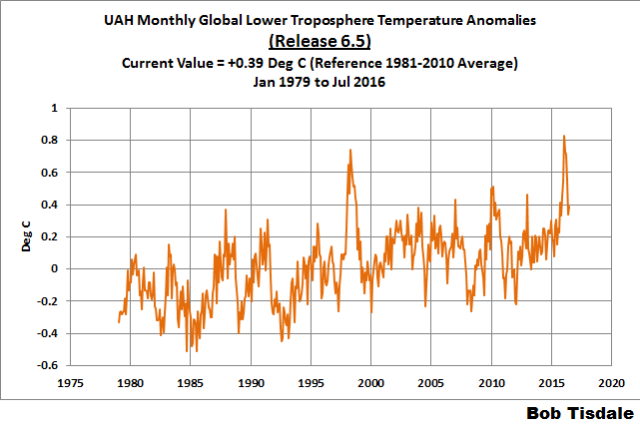
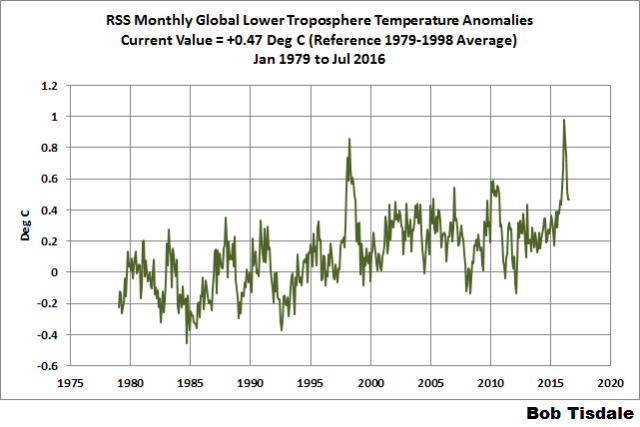
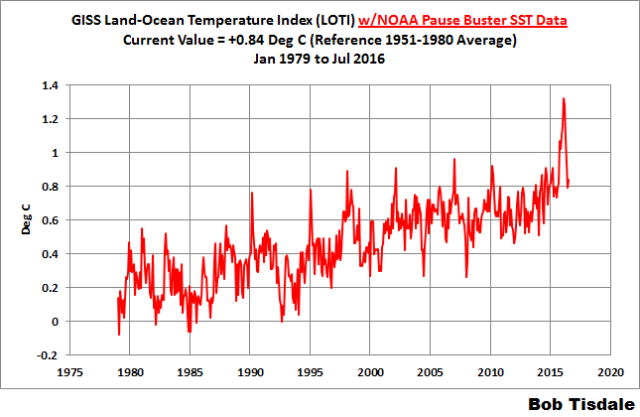
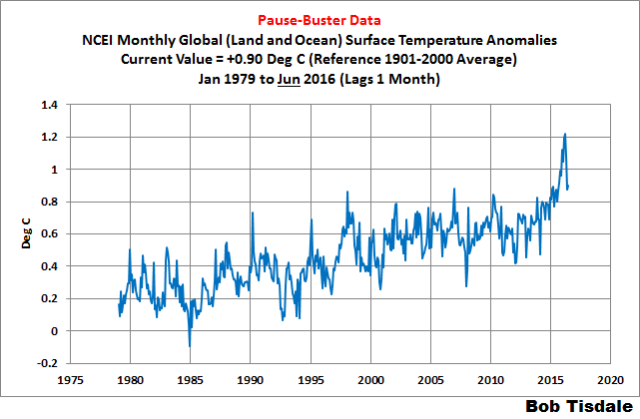



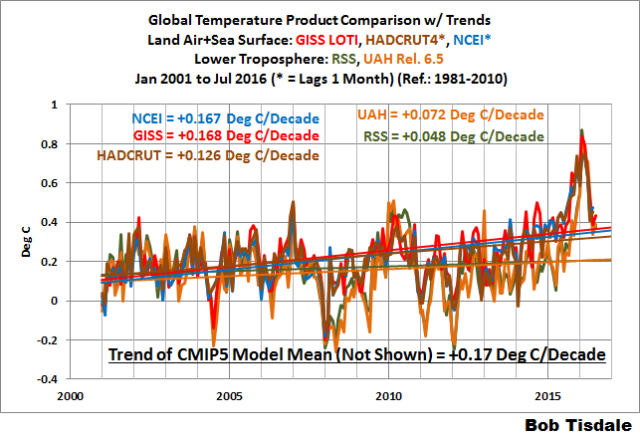

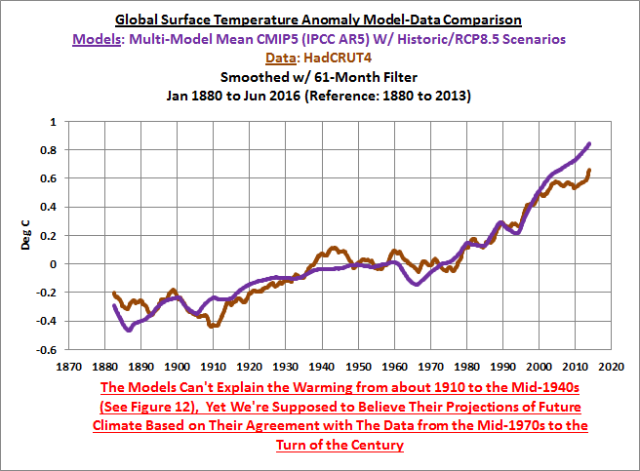

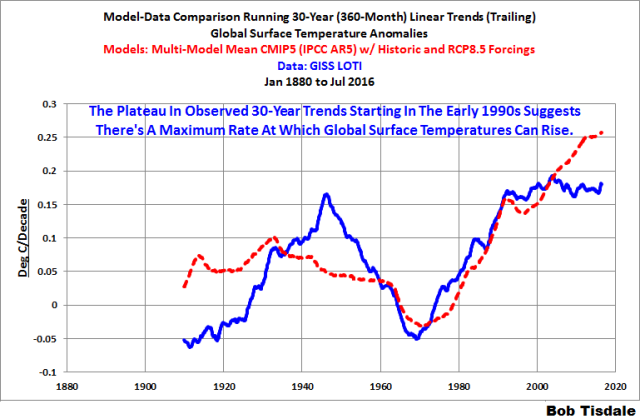
http://globalenergybudget.com/#Cloud
This chart and info. shows how global cloud coverage effects the albedo which in turn has a climate impact. If one takes this into account ,and the lack of any major volcanic activity (explosive index 5 or higher) the strong El Nino just recently along with overall high sea surface temperatures , the recent maximum of solar cycle 24 the result is rather high global temperatures.
Just when you think (like I know so many do) look at the global temperatures look at how warm they are, look at the sea surface temperatures ,how could this trend in global temperatures ever change. That is when change usually comes.
I say going forward global cooling will be the trend and it is hard to go against the given trend but I see a reverse.
Much of the reverse for my two cents being tied into weakening solar and geo magnetic fields which I think will move the terrestrial items which control the climate of the earth into a overall cooling mode.
TERRESTRIAL ITEMS
GLOBAL CLOUD COVERAGE
SEA SURFACE TEMERATRES
VOLCANIC ACTIVITY
ATMOSPHERIC CIRCULATION PATTERNS
GLOBAL SNOW COVER/SEA ICE COVERAGE
ENSO
Thus far all of these indicators as I mentioned above have been in a warm mode when it comes to climatic impact.
The next few years will tell the story keeping in mind any initial cooling will be tied into a transition from an EL NINO to a LA NINA conditions. In-fact the recent slight cooling of late is tied to ENSO which has influenced the climate to a very large degree over the past several years.
So,
it’s warming.
Yes, it is.
It is ?? I’m not feeling the acceleration!!
Too much, and moreover endless repeated information leads over the long term to desinformation and even to misinformation.
Which you do all of the time.
What about publishing HERE AND NOW all examples of what you pretend?
Why am I not surprised? The alarmist troll objects to information that refutes it’s religion.
GISS Loti global for July: 0.84, not 0.79 ( http://data.giss.nasa.gov/gistemp/tabledata_v3/GLB.Ts+dSST.txt )
Graph looks right, just June number not updated?
Yes, the graph has the right number. It’s just that in this text
“Update: The July 2016 GISS global temperature anomaly is +0.79 deg C.”
it should say 0.84 (0.79 was June).
Bob, yet another excellent article. is some of this the data that has been subject to “adjustment” usually in an historical downward path and is the practice still in place to put thermometers in places where they should not be, ie next to runways etc?
Bob,
As always, excellent. One of my favorites is, however, temperature adjustments vs time.
GISS is slowly evolving into a straight line going up.
“GISS is slowly evolving into a straight line going up.”
.
.
OK. You usually do facts, not humor, Bill. But that one made me laugh just visualizing such a graph. Good one.
Professor Humlum at Climate4you notes: “… The net effects of the adjustments [to the GISS global temperature record] made since May 2008 are to generate a more smoothly increasing global temperature since 1880 …”.
They don’t like bumpy graphs:
(Since the revision, says Willis, the bumps in the graph have largely disappeared, which means the observations and the models are in much better agreement. “That makes everyone happier,” Willis says.)
http://earthobservatory.nasa.gov/Features/OceanCooling/page4.php
They don’t like bumpy graphs mk. 2:
(It would be good to remove at least part of the 1940s blip,
but we are still left with “why the blip”.) Phil Jones, Climategate email:
http://di2.nu/foia/1254108338.txt
I see people posting that July 2016 was the hottest month since history began, citing NASA. How can I tell them its BS and not to panic? Or should I panic?
I know where they are coming from. Namely that earth’s temperature varies by 3.8 C during the year with July the hottest and January the coldest. So a 0.84 C anomaly in July means a warmer earth than a 3.8 C anomaly in January.
However it is GISS that has the hottest July on its record. Both satellites do NOT have July 2016 as the hottest July. That happened in 1998 and we are still here.
A) Since “history began” means since data were systematically gathered, starting at the tail end of the Little Ice Age in the late 1800’s. Why would anyone not expect warming after an Ice Age?
B) The most accurate measurements from the two satellite data sets indicate that this July was not as hot as in 1998
C) Both 1998 and this year were influenced by the El Nino cycle, which is a wholly natural phenomenon that recurs regularly, and then peters out. Temperatures in the current such cycle are dropping like a rock as you read this.
Steve R on August 16, 2016 at 8:48 am
No, Steve R: you don’t need to panic at all.
Once again, Werner Brozek shows the incredibly low level of his knowedge concerning worldwide temperature measurements as performed by different institutions using different methods.
It is here evident that he still could not manage to grasp the evidence: namely that GISS temperature anomaly communications differ from those by UAH.
Simply because whilst the latter are computed respectively to their mean absolute value of the 1981-2010 period, those of GISS are wrt the mean absolute value of 1951-2000, a period during which absolute temperatures were lower than between 1981 and 2010: GISS anomalies are in the average over 30 years higher by 0.43 °C, which must be subtracted from every GISS value when compared with that of UAH.
Here is a list of UAH and GISS anomalies for jan-jul 2016 (UAH on colums 3, GISS on 4):
2016 1: 0,54 0,68
2016 2: 0,83 0,90
2016 3: 0,73 0,85
2016 4: 0,71 0,66
2016 5: 0,55 0,50
2016 6: 0,34 0,36
2016 7: 0,39 0,41
Do you know what the average UAH anomaly for 1998 was? It was 0.484. Do you know what the average was for the last 12 months? It was 0.480.
However for GISS, the last 12 months was WAY HIGHER than 1998!
However for GISS, the last 12 months was WAY HIGHER than 1998!
Here again, Werner Brozek, you give a proof of no more than incompetence.
1. A chart comparing UAH6.0beta5 and GISS land+ocean anomalies for 1979-2016:
http://fs5.directupload.net/images/160816/vx6pwre9.jpg
2. A chart comparing UAH6.0beta5 and GISS land+ocean anomalies superposed for jan 1997 (2015) till jul 1998 (2016)
http://fs5.directupload.net/images/160816/6hvutddz.jpg
As you can see, GISS is NO WAY HIGHER than 1998. It is below UAH for both Niños.
The troposphere is quite a bit cooler than are the surfaces, excepted during hot El Niños. Thus no wonder that GISS’ temperature trend is higher than UAH’s (0.163 ± 0.006 °C / decade compared with 0.123 ± 0.008 °C for UAH).
And through this different trend, GISS mean difference between jan 2015/ jul 16 and jan 1997/ jul 98 (0.38 °C) of course is higher than that for UAH in the same periods (0.21 °C).
That’s all.
WHAT? See:
http://www.woodfortrees.org/plot/gistemp/from:1997/mean:12/plot/gistemp/from:1998/trend/plot/rss/from:1997/offset:0.24/mean:12/plot/rss/from:1998/trend/offset:0.24
WHAT? See:
http://www.woodfortrees.org/plot/gistemp/from:1997/mean:12/plot/gistemp/from:1998/trend/plot/rss/from:1997/offset:0.24/mean:12/plot/rss/from:1998/trend/offset:0.24
Oh yes! The good old 1998 play. I have a different view on all that… see above.
I apologize: the incompetent one here, that’s me 🙂
Since 1998 was so similar to 2016 according to ENSO and RSS and UAH, what is wrong with that?
I accept your apology.
Since 1998 was so similar to 2016 according to ENSO and RSS and UAH, what is wrong with that?
Thanks for accepting the apology, but that can’t hide our completely different views.
1. According to the Multivariate ENSO Index, those two years were certainly not similar, look at the three superposed El Niños:
http://fs5.directupload.net/images/160817/vn4z9v3a.jpg
You clearly can see that starting here with month 13 alias january 1998 (2016), the 2015/2016 edition is by far weaker.
2. The same holds for the troposphere anomalies: look above at the GISS+UAH comparison for 1997/98 with 2015/16, and you see that though normalized to their respective begin, the 2016 anomalies are by far weaker than those of 1998 (compare dark red with medium red in the chart).
3. This is no wonder. Compare the MEI data for 1982/83, 1997/98 and 2015/16, and build the three MEI means of all values above zero (El Niño mode):
– 1982/83: 1.84
– 1997/98: 2.18
– 2015/16: 1.29 (!!!)
The last El Niño edition keeps the weakest in all comparisons; the podium always shows:
1. 1997/98
2. 1982/83
3. 2015/16
If you really look at some data, it can’t reasonably be the same as that I look at:
– MEI: http://www.esrl.noaa.gov/psd/enso/mei/table.html
– UAH6.0beta5: http://www.nsstc.uah.edu/data/msu/v6.0beta/tlt/uahncdc_lt_6.0beta5.txt
– GISS land+ocean: http://data.giss.nasa.gov/gistemp/tabledata_v3/GLB.Ts+dSST.txt
So what remains is that yes: if we restrict our view to 1997-2016, GISS anomalies are higher in trend than UAH’s or those of RSS (in its revision 3.3 of course!!!).
How can you expect thermometric surface measurements be identical or at least comparable with O2 brightness measurements made at an atmospheric altitude of about 4 km?
I went by ENSO numbers from here:
http://www.cpc.noaa.gov/products/analysis_monitoring/ensostuff/ensoyears.shtml
I am not an expert on which method is best so I will try to not embarrass myself by discussing things I am not sure about.
Why panic! Warm is better than cold and more co2 is better than less. These conditions make FOOD! Besides it’s been like this before and life flourished.
It was a lot hotter than this earlier in the Holocene and humans really florished.
Bob, all your data must be wrong !!!
Here in Canada our National Post newspaper is running a story by Seth Borenstein referencing Gavin and NOAA say’s we’re the hottest eva , be very afraid BwaHaHaHaHa
http://news.nationalpost.com/news/world/july-was-earths-hottest-month-in-recorded-history-the-10th-record-hot-month-in-a-row-nasa /sarc
What should we make of this:
https://www.theguardian.com/environment/2016/aug/16/july-2016-was-worlds-hottest-month-since-records-began-says-nasa
Bird cage liner.
… bird cage liner?
I noticed an article from the CBC that claims that this July is the hottest ever. Maybe based on the NOAA data set, but the other four don’t look very spectacular.
Anomalies in 2016 (Jan-Jun) wrt mean 1981-2010 for
UAH6.0beta5, GISS, HadCRUT4, NOAA (all surfaces: land+ocean)
2016 1 0,54 0,68 0,61 0,62
2016 2 0,83 0,90 0,76 0,77
2016 3 0,73 0,85 0,77 0,79
2016 4 0,71 0,66 0,63 0,65
2016 5 0,55 0,50 0,39 0,45
2016 6 0,34 0,36 0,44 0,47
I didn’t fetch july values for HadCRUT4 / NOAA.
But it is at least GISS’ hottest july …
Oh, and whenever NOAA’s temperature series is discussed, it should be done with this image in the foreground.
http://www.ncdc.noaa.gov/img/climate/research/ushcn/ts.ushcn_anom25_diffs_urb-raw_pg.gif
Yes of course! But… do you have the same image from UAH? I guess you will never get it.
How can the UAH (measuring global Satellite troposphere temperatures since 1979) be “correcting” a temperature differences plot extending from 1900 to 2016?
The local surface air temperatures, however, have been “adjusted” continuously (well, in each release) from their written records in the entire period of 1900 – 1920 – 1940 – 1960…
It is evident that I didn’t mean that period. I meant the wonderful “corrections” applied between 1979 and 2015 at the time 6.0beta was released.
Did you ever plot the zonal diffs between 5.6 and 6.0beta5?
You’ll love it, especially those for NoPol / SoPol.
It doesn’t exist. UAH isn’t looking at a temperature reading to adjust.
stevekeohane on August 17, 2016 at 8:10 am
UAH isn’t looking at a temperature reading to adjust.
Interesting point of view!
End of april 2015, UAH’s revision 6.0 was released. It contains huge adjustments when compared with UAH 5.6.
Feel free to download the data produced by the two revisions and to compare them! I did.
Look at: https://moyhu.blogspot.de/2015/12/big-uah-adjustments.html
to have a first idea…
Jeff in Calgary on August 16, 2016 at 10:38 am
Oh, and whenever NOAA’s temperature series is discussed, it should be done with this image in the foreground.
When you publish such a chart, it would be fair to give a hint on what the data plotted is exactly originating from:
http://www.ncdc.noaa.gov/oa/climate/research/ushcn/ushcn.html
Bob,
In a future report, I think that it would be instructive to plot SSTs along with land surface temps to see how each regime is behaving. I suspect that, because of the greater thermal inertia of water, the SST may be a lagging indicator of what is happening. Directly comparing the two would provide insight on how the SST is influencing the composite temperatures.
Hello Clyde – please see my post below at
https://wattsupwiththat.com/2016/08/16/july-2016-global-surface-landocean-and-lower-troposphere-temperature-anomaly-update/comment-page-1/#comment-2279512
Nino3.4 SST LEADS Lower Troposphere (LT) temperature by about 4 months. This small area of the planet, abut 1% of Earth’s total area, predicts average LT temperature quite well, except for several years following major volcanoes.
https://www.climate.gov/news-features/understanding-climate/climate-variability-oceanic-ni%C3%B1o-index
Climate Variability: Oceanic Niño Index
Author:
LuAnn Dahlman
August 30, 2009
-updated Feb. 11, 2016
[excerpt]
The Oceanic Niño Index (ONI) is NOAA’s primary indicator for monitoring El Niño and La Niña, which are opposite phases of the climate pattern called the El Niño-Southern Oscillation, or “ENSO” for short. NOAA considers El Niño conditions to be present when the Oceanic Niño Index is +0.5 or higher, indicating the east-central tropical Pacific is significantly warmer than usual. La Niña conditions exist when the Oceanic Niño Index is -0.5 or lower, indicating the region is cooler than usual.
To calculate the ONI, scientists from NOAA’s Climate Prediction Center calculate the average sea surface temperature in the Niño 3.4 region for each month, and then they average it with values from the previous and following months. This running three-month average is compared to a 30-year average. The observed difference from the average temperature in that region—whether warmer or cooler—is the ONI value for that 3-month “season.”
https://l.facebook.com/l.php?u=https%3A%2F%2Fwobleibtdieglobaleerwaermung.wordpress.com%2F2016%2F08%2F15%2Fkalter-nordatlantik-schwache-sonne-jahrhundertwinter-201617-wie-196263%2F&h=FAQG2S_L_
“Namely that earth’s temperature varies by 3.8 C during the year with July the hottest and January the coldest.”
How odd. The Atlantic and the Arctic are also the best places to study climate too, so I hear
Earth has a buttock too – a big wet one, with ice (lots of it) in its centre. It is also closer to the sun during comparative summers?
Straws being split within a few 10’s of 1C? I buy none of it
For an article on this point, see:
http://theinconvenientskeptic.com/2013/03/misunderstanding-of-the-global-temperature-anomaly/
Bob thank you so much for your vigilance with this. I have learned so much from you in the past 2 years. Excuse me while I vent.
I believe that liberal alarmists will go to great lengths to ensure that this temp value NEVER goes back down. Vigilance will be needed now more than ever. I mean it. We will see a new adjustment algorithm as well as greater numbers of daily temp logging “errors” rate reaching new heights over 40%?. Data is my forte!! These alarmists operate by hook or by crook all in the name of “GOOD!” These CSers are nuts. I lost a position because of them in the past and am NO LONGER EVER SURPRISED by ANY of their Actions!. I mean these guys “correct” acquired data constantly (such BS). Change “Natural variances” with the snap of their magical keyboards all the while proclaiming that they know best. Actually some times they even say it out loud, it was too low so I kicked it up a few degrees and then go on as if nothing just happened. It is truly unbelievable how much of their crappola gets through any peer review (oh ya, peers of scum are scum some times, that’s right!. Scientists my ARSE)
These nut cases use complex statistical models to validate their SEMIemperical data generation models by semi modeling nature (only a FEW of the known variables included (but not really defined without a lengthy FOIA req.)) without ever even considering if the magnitude of the response is even germane given the large experimentation error of the equipment to data resolution claims…., (you know signal value of 0.01 and a noise value in excess of 0.45 “ERROR” all the while claiming model validation is not really necessary because they are after all the MODEL KINGS so shut up you peons because we KINGS ALL AGREE HOW GREAT WE ARE because they really think we are too damn stupid to see that their MODELS ARE SO FULL OF HOLES AND FRAUD!!!!
Well guess what…, I SEE YOU!
Just once I would like to see REAL NATURE PROVIDED DATA, not screwed with, acquired “ABOVE BOARD” with all parameters and stats declared a priori and of course…,ALL VALUES ACCOUNTED FOR, no new this sleazy twist or semi empirically generated that, just a straight forward well planned and executed experiment by an alarmist and when it fails say damn, this CO2 thing ain’t near what OBAMA has been telling his minions of change…, er, scientists!
Have a great day all. TEACH THE MASSES WHAT IS REAL
https://www.facebook.com/photo.php?fbid=1043110235766538&set=a.1012901982120697.1073741826.100002027142240&type=3
https://wattsupwiththat.com/2016/08/08/will-2016-set-satellite-records-now-includes-june-and-july-data/comment-page-1/#comment-2273977
As I posted previously, this formula predicts UAH LT temperature ~four months in the future from Nino3.4 index, with an R2 of 0.55 since 1996. The formula is (approx.):
UAH LT calc. = 0.20*Nino3.4Anomaly + 0.15
https://wattsupwiththat.com/2016/07/20/new-research-shows-that-californias-sierra-nevada-snowpack-will-likely-not-recover-from-the-current-drought-until-2019/comment-page-1/#comment-2261569
The Nino3.4 Anomaly data is here:
http://www.cpc.ncep.noaa.gov/data/indices/sstoi.indices
Recent 2016 UAH LT calc. using this formula are:
July 0.49C calc. (vs actual UAH LT 0.39C)
August 0.37C calc.
September 0.21C calc.
October 0.13C calc.
November 0.05C calc.
Regards, Allan
Bob Tisdale, thank you again.